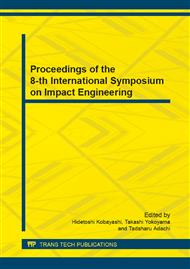p.493
p.499
p.505
p.511
p.517
p.525
p.530
p.536
p.542
A FEM Study on Adiabatic Shear Band Formation in Tube Compression Driven by Electro-Magnetic Loading
Abstract:
The adiabatic shear bands (ASB) of the thick-walled cylinder have been studied by many researchers in the recent years. The onset and evolutions of the multiple shear failure of metal cylinder under explosive loadings are affected by many factors such as the characteristics of the impulsive loadings, the dynamic behavior of the materials, etc. In this work, a tube compression driven by electro-magnetic forces is introduced, which enables to carry out the experiments of the spontaneous evolution of multiple adiabatic shear bands in metal tube. The FEM simulation was conducted to investigate the evolution process of strain localization with coupled thermo-mechanical analysis. The FEM results show that ASB initiates when the stress drops rapidly and strain growth and not when it reaches the maximum shear stress. Once the shear band is formed, elastic unloading occurs beside the shear band. The different behaviors of the damage introduced in the strain softening model affect the initial nucleation strain and the distribution of ASBs. With the increase of material damage softening, the initial strain of shear band decreases and the number of shear bands increases.
Info:
Periodical:
Pages:
517-521
Citation:
Online since:
June 2014
Authors:
Price:
Сopyright:
© 2014 Trans Tech Publications Ltd. All Rights Reserved
Share:
Citation:


